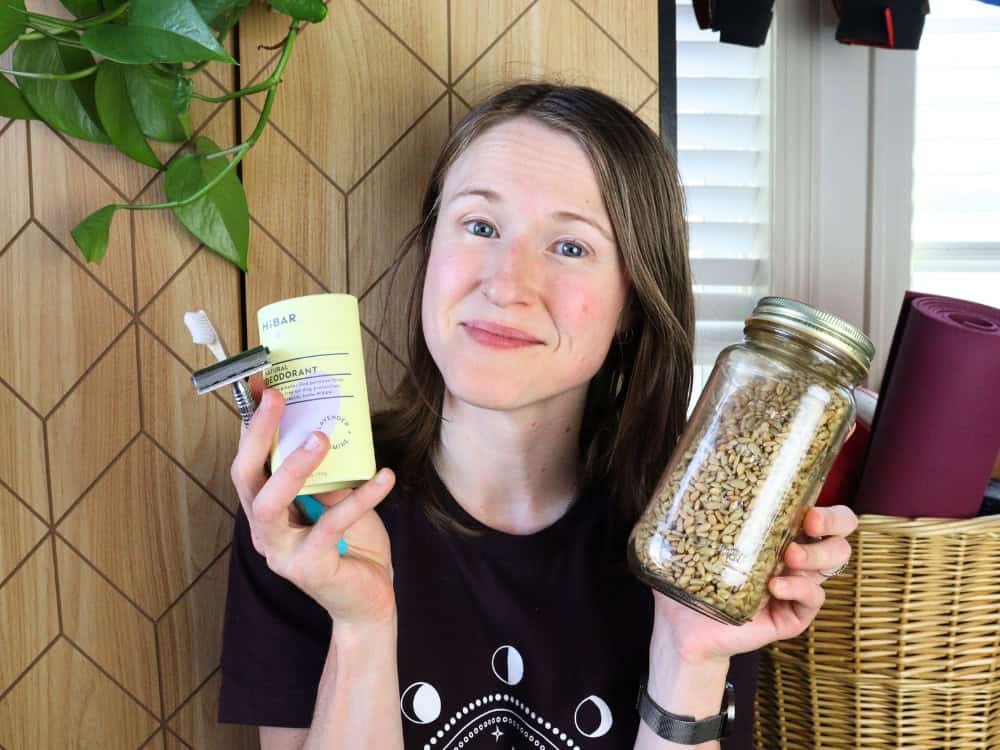
21 Zero Waste Tips For Low Impact Living
Each day, Americans discard 4.9 pounds of trash per person. That’s almost 1,800 pounds per year.
The take-make-waste economy is responsible for vast amounts of GHG emissions, water pollution, and land pollution.
While there are many zero waste solutions to these problems, we’re here to help you get started on the right eco foot(print) with some zero waste tips for beginners.
Before we (dumpster) dive in, here’s’ a quick refresher on the 5 Rs of zero waste living from Bea Johnson of Zero Waste Home:
- Refuse what you do not need
- Reduce what you do need; reconsider how much stuff you actually need
- Reuse by repurposing items or by using reusable objects like metal straws
- Recycle what you cannot refuse, reduce or reuse
- Rot (compost) the rest
And remember: zero waste is a journey, not a destination, and it’s all about the difference you can make along the way.
Not all zero waste ideas will work for everyone, and that’s okay. Start small and add in new steps when you can. ‘Progress, not perfection’, we like to say. We’re all learning as we go.
The Full List Of Zero Waste Living Tips
Zero Waste Tips: Refuse
- Refuse single-use plastic when out and about
- Avoid disposable kitchen items
- Go zero waste in the bathroom
- Raise a zero waste baby
- Make plastic-free pet swaps
- Create a zero waste home office
Zero Waste Tips: Reduce
- Reduce food packaging
- Buy fewer clothes
- Avoid unnecessary technology upgrades
- Give/receive non-material gifts
Zero Waste Tips: Reuse
- Reuse glass jars
- Learn to repair items
- Upcycle clothes, textiles, and furniture
- Buy secondhand
- Sell, swap, and donate pre-loved items
Zero waste Tips: Recycle
- Prioritize easy-to-recycle packaging
- Check local recycling rules
- Research options for harder to recycle items
Zero Waste Tips: Rot
Refuse
1. Refuse Single-Use Plastic When Out & About

Short-lived at best and single-use at worst, plastic consumables are piling up in landfills at staggering speeds.
The easiest changes to make while going zero waste are simply refusing such items and using a longer-lasting and environmentally friendly alternative.
When you’re out and about, say no to:
- Plastic water bottles and takeaway coffee cups: Instead, invest in a reusable, eco-friendly water bottle and reusable coffee cup.
- Plastic grocery bags: Do all your shopping (grocery or otherwise) with reusable totes and cotton or mesh produce bags.
- Plastic cutlery and straws: There are loads of stainless steel or bamboo alternatives, and many eco-friendly cutlery sets come with handy storage bags.
2. Avoid Disposable Kitchen Items
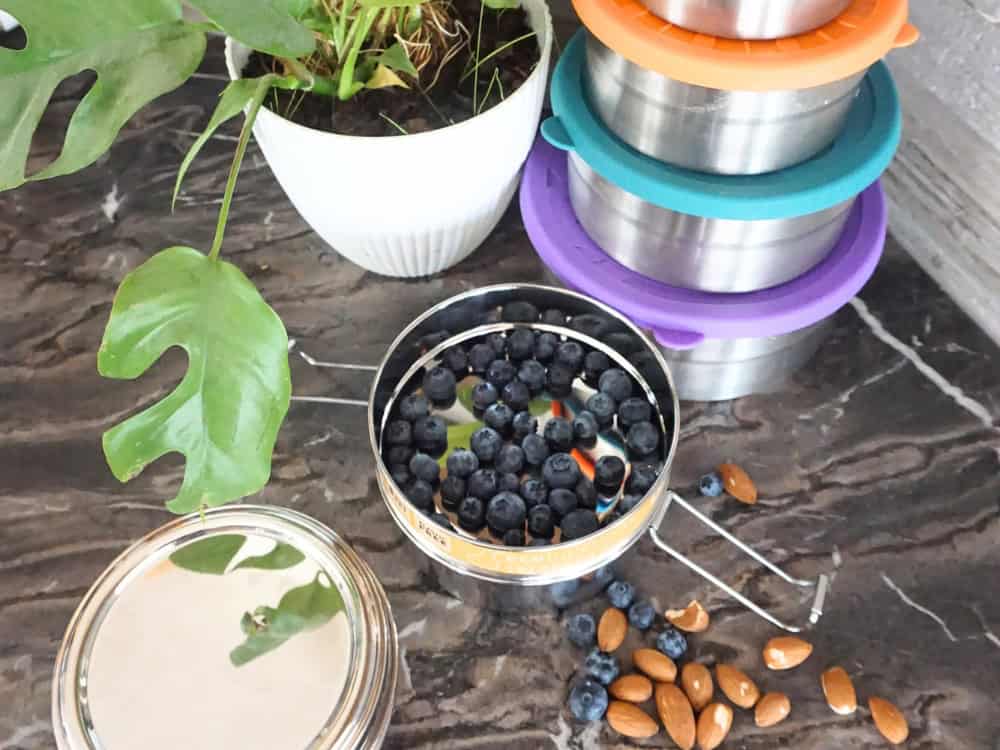
There are so many refusals to get you on your way to a zero waste kitchen and it’s a great place to start when you’re looking for how to go zero waste at home.
- Coffee and tea: The non-recyclable waste from single-serve coffee machines is enough to wrap around the planet ten times. Opt for a French press or stovetop coffee maker. Already have a coffee machine? Some sustainable coffee brands offer compostable or recyclable pods.
- Napkins and paper towels: Replace these with reusable paper towels and cloth rags.
- Disposable dinnerware: Sure, it’s easier to take out the trash than wash all those backyard BBQ dishes, but sticking to reusable dinnerware is much better for the planet.
- Sandwich bags and plastic wrap: Zip up and lock out all Ziploc. Eco-friendly alternatives to Ziploc bags include Stasher’s reusable silicone bags, reusable cotton sandwich bags, and carnauba or beeswax wraps.
- Plastic sponges: Ditch the plastic sponges and use compostable scrubbers (like real loofahs or coconut coir pads) instead.
- Garbage can liners: Try ditching liner bags and using newspaper instead, or at least swap to recycled plastic trash bags instead.
3. Go Zero Waste In The Bathroom
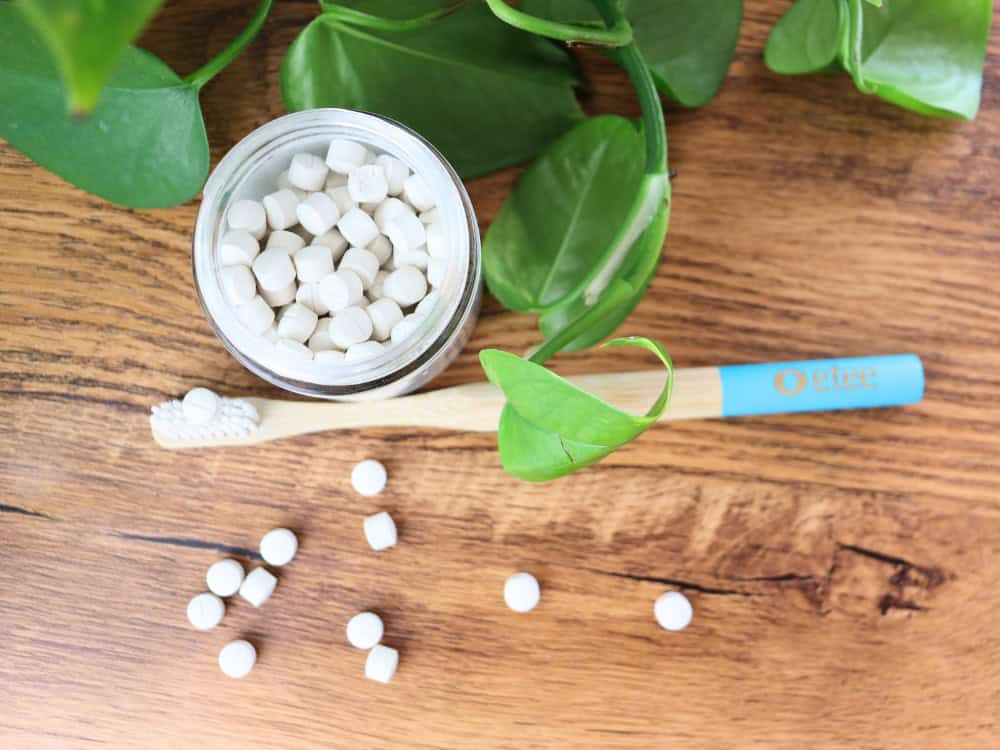
It sounds funny when you consider a bathroom’s most essential function is to deal with human waste, but a zero waste bathroom is totally possible through more conscious shopping and greening your daily routines. Be sure to refuse:
- Virgin pulp toilet paper: Producing one roll of toilet paper out of virgin tree pulp uses 1.5 pounds of wood, 37 gallons of water, and 1.3 KWh of electricity. Switch to bamboo or recycled altermatives, like Who Gives a Crap, or if you really want to go for zero waste toilet paper, try reusable cloths and a bidet.
- Plastic razors: Save tons of money (not to mention billions of disposable razors hitting the landfill each year) by shaving with a reusable zero waste safety razor.
- Tampons and period pads: For a zero waste period, swap to a menstrual cup (like the Saalt and Diva Cups), reusable period pads, or sustainable period underwear like those by Modibodi.
- Plastic toothbrushes, toothpaste paste tubes, and floss: Keep your pearly whites and the planet clean with zero waste toothpaste, compostable floss, and a plastic-free sustainable toothbrush.
- Plastic deodorant containers: Plastic deodorant tubes are rarely recycled properly. That’s senseless waste, especially given the many sweet-smelling zero waste deodorant options.
- Soaps packaged in plastic bottles: Use bars ( which are either naked or in compostable cardboard) instead. Bars also make the best zero waste shampoo and conditioners, but if you prefer liquid soap, you can often find it in bulk stores to refill your reusable container.
- Plastic-packaged beauty and skin care products: Start phasing out packaging across your entire personal care routine. Pretty much everything you can think of, from zero waste mascara to zero waste sunscreen, now has eco-friendly, low-waste alternatives.
- Nylon toilet brushes: Once your current one gets a little nasty, replace it with a biodegradable toilet brush with a wooden handle and plant fiber bristles.
- Separate cleaning products for everything: Downsize your cleaning routine to one or two zero waste products. Vinegar and baking soda (both of which you can find in bulk) are all you need! Instead of toxic synthetic fragrances, scent it by steeping lemon or orange peels in your vinegar for a few weeks.
4. Raise A Zero Waste Baby
Some of the best practices for raising a zero waste baby call for fewer products, and refusing
- Disposable diapers: Reusable cloth diapers are in. Once you learn how to wash cloth nappies and get into a routine, it becomes second nature (and you’ll be helping to curb the 300,000 disposable diapers that end up in landfill each year).
- Single-use wipes: Create your own from old natural fabric clothes (hemp and cotton are ideal), or stock up on reusable eco-friendly baby wipes for the greenest bum cleaning routine.
- Separate soaps: Many organic shampoos are suitable for the whole family, so buying separate products for your little one is not always necessary.
5. Make Plastic-Free Pet Swaps

Is a zero waste dog, cat, or other furry friend possible?
With a few eco-swaps, you can be well on your way:
- Plastic-wrapped treats and dog food: Making your own dog (or cat) food is the most sustainable option but requires some commitment. Otherwise, look for sustainable dog food and eco-friendly cat food that uses compostable or recyclable packaging.
- Dog poo bags: To clarify, we’re absolutely not advocating just leaving the poo. But instead of using individual plastic baggies, swap over to compostable dog bag rolls or just plain newspaper!
- Non-biodegradable pet toys: Ditch the plastic and opt for eco-friendly dog toys made from natural, ideally organic materials.
- Nylon and polyester pet products: Put your paws up collars and sustainable dog beds made of natural fibers that can be composted once Fido gets a little too chewy-happy.
6. Create A Zero Waste Home Office
A home office can create a whole bunch of unnecessary waste. Say sayonara to:
- Disposable pens: Use refillable fountain pens instead and feel like a modern Hemingway. For other stationary, stock up on zero waste school and office supplies like eco-friendly notebooks, recycled paper, and sustainable pencils.
- Unnecessary printing: Ask yourself, “Do I really have to print this?” Be as digital as possible and set the goal of turning that printer/scanner into just a scanner.
- Paper mailers and junk mail: Keep the digital trend going by opting out of paper mailers. Cancel phone directories, sign up for paperless billing, and place a “no junk mail” sticker on your mailbox.
- Books, magazines, and newspapers: Save the trees by getting a (free!) library card, eReader, or Audible membership. You can also subscribe to PDF versions of any major newspaper. If you love holding a physical book, buy secondhand or start a book swap with friends.
- Non-rechargeable batteries: Well-made eco-friendly electronics are great at helping us reduce waste, but remember to power your devices with rechargeable batteries.
Reduce
7. Reduce Food In Packaging
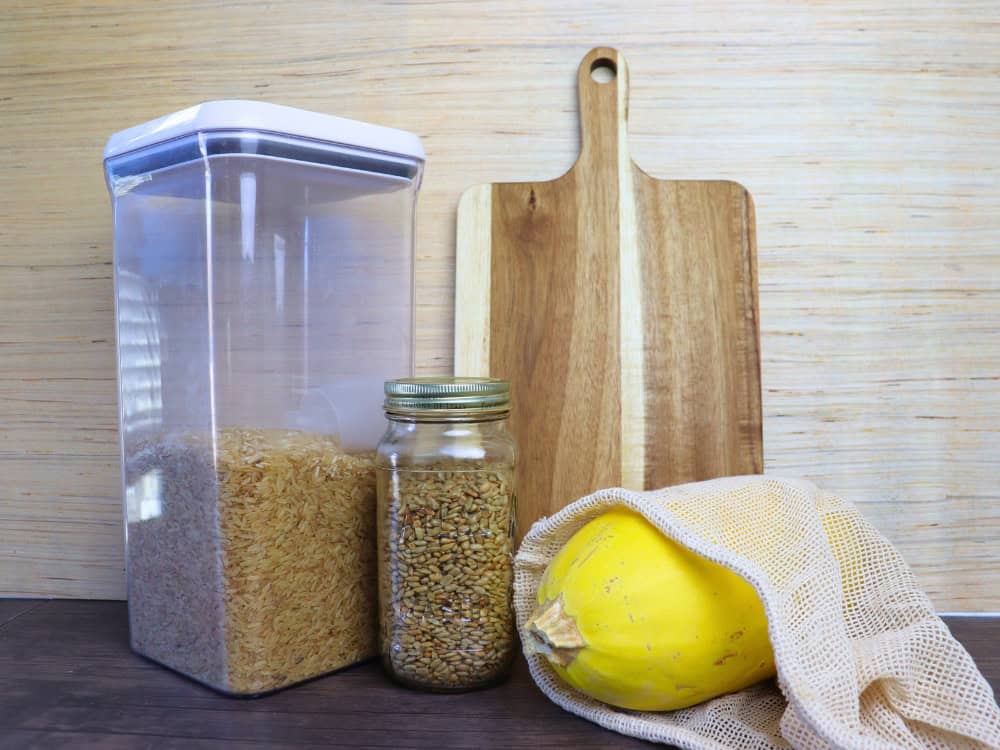
For items you can’t outright refuse or avoid, try to reduce how much of them you buy or reduce the amount of waste they generate.
Packaging, and in particular food packaging, is a big one, so buy as much in bulk as possible. A zero waste pantry reduces heaps of plastic and cardboard waste. Zero Waste Home’s bulk finder app may help you locate one nearby bulk. Alternatively, there are many online zero waste stores you can use.
For fresh fruit and veg, bypass the supermarket and head to your local farmers market or organic grocery store to avoid unnecessary plastic, stickers, and ties. Don’t forget your reusable produce bags!
Shop at bakeries, patisseries, and delis where you can bring your own bag or container, too, or try making these at home instead.
8. Buy Fewer Clothes

One of the best tips for zero waste living is to adopt a minimalist mentality and stop buying stuff you don’t need. Your wardrobe is a great place to start.
Challenge yourself to buy fewer new clothes or even go so far as to #neverbuynew. Make an adventure out of hunting down super stylish second hand duds or clothing and dress rentals.
If you need to buy something new, buy only what really fits and what you absolutely love. Always choose well-made pieces from ethical clothing brands, even if they cost more (hint: there’s a reason for that).
9. Avoid Unnecessary Technology Upgrades
Nowadays, gadgets are designed with planned obsolescence in mind, and it’s almost cheaper to buy new ones when they break. Try to break the cycle.
Buy well-made, warranty-backed items, and if something happens, repair them; don’t replace them. We call this our “slow tech philosophy.”
If you need to replace, buy secondhand if you can, and make sure you properly dispose of old electronics.
10. Give/Receive Non-Material Gifts
Ask for a donation or an experience gift that doesn’t cost the earth (e.g., dinner for two or tickets to a movie or sporting event).
If giving a gift, employ the same philosophy.
If you buy material gifts (ideally zero waste gifts or general eco-friendly gifts) make sure the recipient will definitely use them.
Reuse
11. Reuse Glass Jars & Other Containers
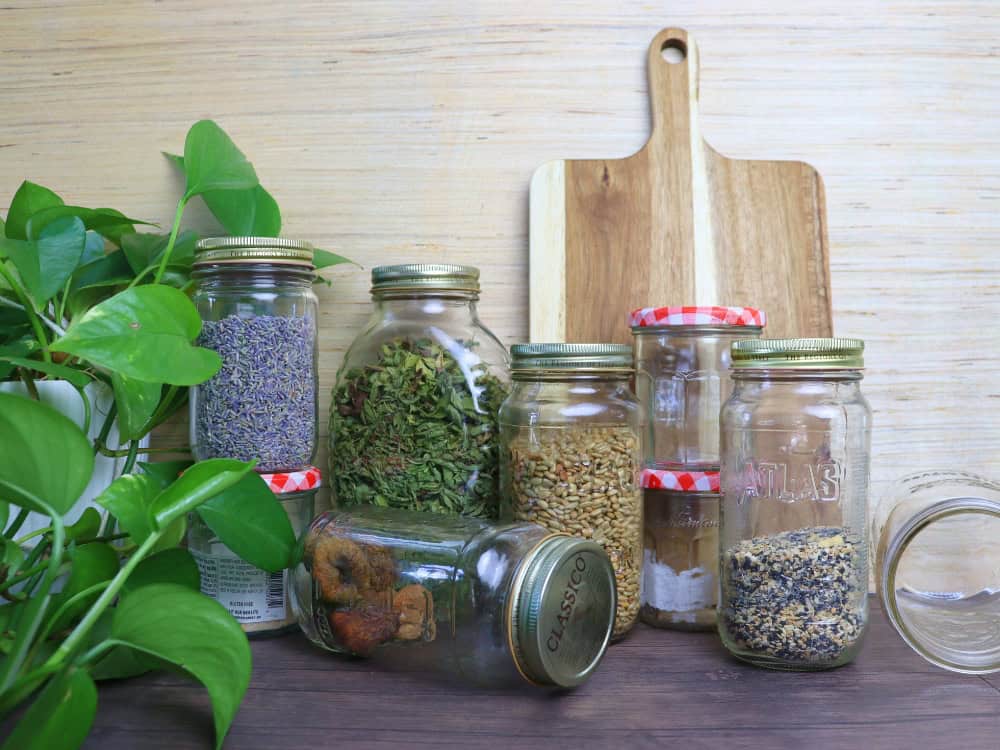
Reusing is a brilliant way to reduce waste (and save you money!).
While we’ve included reusable product suggestions throughout this list to help you avoid using disposable items, we ALWAYS advocate for using what you already have before buying new.
Jars are the zero waster’s best friend and one of the best plastic-free food storage containers. Use them to stock up on bulk goods and store prepared meals and snacks.
Their non-food uses are limitless, too, from candle holders and flower vases to pen holders and craft supply storage.
12. Learn To Repair Items
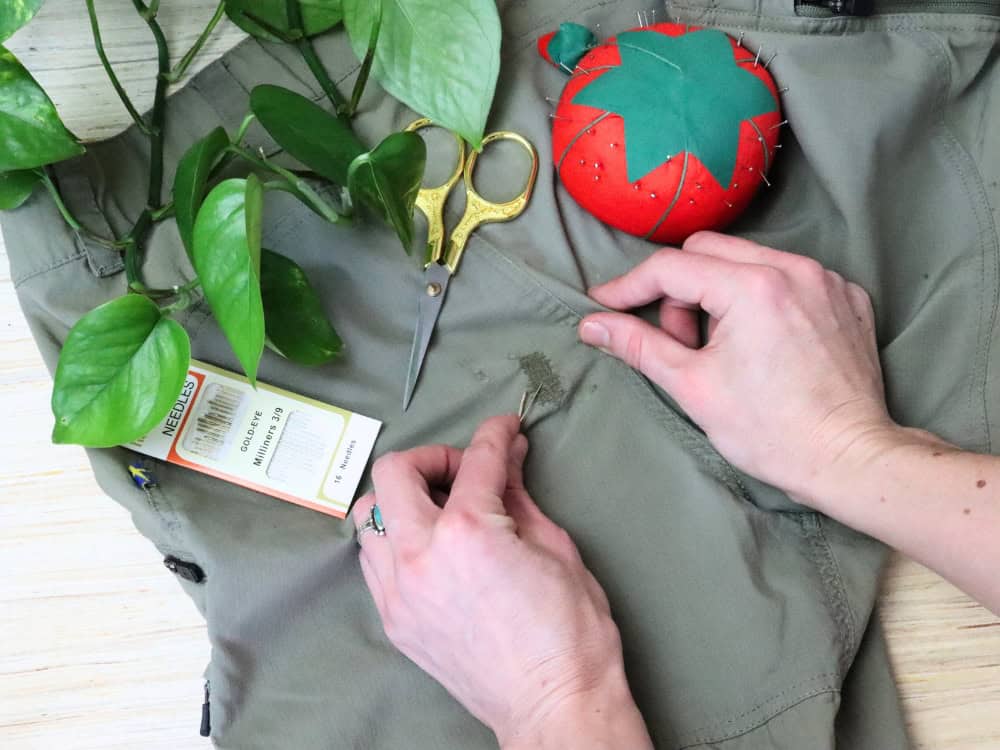
Keeping items in use for as long as possible is one of the best ways to create a waste-free life.
- Learn basic sewing skills: If you’re wondering what to do with old socks, for example, and the only thing wrong with them is a hole or two, then learning how to darn them can give them a new lease of life. The same goes for clothing.
- Mend or reupholster furniture: Repairing items before replacing them saves waste, and your wallet will thank you, too. If it’s beyond your DIY capabilities, find a locally skilled person who can help.
- Head to a local repair cafe. Repair cafes are popping up everywhere and are a great place to seek help for more challenging fixes, such as small appliances and electronics. There are also heaps of online guides for tackling repairs yourself, including those on iFixit.
13. Upcycle Clothes, Textiles, & Furniture
Whether we’re talking clothing or home decor, you don’t need to buy new to achieve a fresh look. Getting busy with creative repurposing is key to living waste-free.
- Turn old clothes into new ones: Upcycling clothes is the way fashion forward. Give your wardrobe a makeover by turning jeans into shorts, a men’s shirt into a cute shirt dress, an old sweater into a beanie hat—the options are endless.
- Repurpose textiles: There are (probably) hundreds of things you can do with old clothes, towels, blankets, bedding, and curtains. Try turning an old T-shirt into a no-sew tote bag, old bedsheets into a rag rug, and if all else fails, cut old fabric into pieces to use as reusable cleaning cloths.
- Upcycle old furniture: It’s impressive what a new coat of paint, wallpaper, and updated handles can do. Check out Pinterest for plenty of ideas.
- Upcycle newspapers and magazines: Old magazines, newspapers, maps, and damaged books can easily be repurposed into gift wrapping, craft materials, or home decor.
14. Buy Secondhand
From popping tags at your local thrift store to snagging an eBay bargain, there’s no shortage of options for secondhand shopping.
Collating a secondhand wardrobe is one of the best ways to avoid fast fashion. From vintage to designer, there are pre-loved bargains galore for every sustainable fashionista.
But thrifting isn’t limited to just clothes. Save the trees by buying secondhand wooden furniture or items made from reclaimed wood. Well-made wooden furniture lasts decades, and plenty of pieces are waiting to be rehomed. Don’t forget the matching kitschy decor to go with it!
15. Sell, Swap & Donate Pre-Loved Items

One man’s trash is another man’s treasure. Even if you don’t have a use for something, someone else might.
Donate your unwanted items to charity or thrift stores, or find someone who wants them on sites like Craigslist, Facebook Marketplace, and Freecycle.
For old clothes that are still in good condition, consider platforms such as thredUP, Poshmark, and Depop. You can earn extra money while ensuring your clothes go to someone who’ll wear them.
Many of our favorite circular economy companies, including Patagonia and Mud Jeans, support circular fashion with take-back schemes and pre-loved programs. You’ll often receive store credit for trading in your old items.
Recycle
16. Prioritize Easy-To-Recycle Packaging
Reserve recycling for items that can’t be refused, reduced, or reused.
While there will inevitably be some items you need to recycle, try only to buy items that come in easy-to-recycle packaging, like cardboard, glass, and aluminum.
Some types of plastic are more difficult to recycle than others. Check your local recycling rules if unsure.
17. Check Local Recycling Rules
Local recycling rules differ, so make sure you know what they are to maximize the amount of waste that actually gets recycled.
Guidelines about what can and can’t be recycled and how items should be sorted can generally be found on council/municipality websites.
Sometimes, contamination is due to “wish-cycling,” putting an item in the recycling bin and hoping it will be recycled. It’s important to avoid such recycling contamination, as it could mean that an entire lorry load of recycling is rejected and has to be landfilled or incinerated instead. If in doubt, leave it out.
18. Research Options For Harder To Recycle Items
Some categories of items are easier to recycle than others. There are plenty of options for where to recycle old clothes, for example.
Before you throw something in the trash, pause for a second. A surprising number of items can be recycled at specialized facilities.
- Check for local drop-off locations: Supermarkets, for example, often offer a drop-off point for things like batteries and soft plastics.
- Recycle old mattresses: Some eco-friendly mattress brands will take away your old one, and there are numerous third-party mattress recycling services for other old mattresses. Check what’s available in your local area.
- Recycle old pillows: In the US, USAgain has TreeMachine drop boxes that accept old pillows, and in the UK, retailer Dunelm has a take-back scheme in some stores.
- Terracycle: Operating in the USA, UK, and Australia, Terracycle can recycle just about anything. Check whether you have a public drop-off box nearby, and if not, consider starting one. Alternatively, you can buy a Zero Waste Box™ to use at home.
Rot
19. Get Composting!
For everything else, rot (aka compost) it!
Humans throw away a staggering amount of organic, compostable waste—over 60% of waste output in the US.
The word “rot” may not sound exciting, but the benefits of composting are huge, and everyone can do it. You can do it in your yard, on your balcony, or even indoors, thanks to some very clever indoor compost bins.
With a little bit of know-how, composting is a straightforward process. We recommend you start by learning what is compostable and what’s not compostable and take it from there.
20. Collect Food Waste

Food waste accounts for 8% of global GHG emissions.
Reducing is the first step. Learn how to keep produce fresh and preserve food.
Next, learn how to reuse scraps, such as turning vegetable scraps into stock and citrus peels into a homemade cleaner.
With any food waste you can’t reuse, it’s time to make compost. Collect food waste in a repurposed container and either compost it at home or check with your local council to see if they offer a food waste collection service.
If not, check the ShareWaste App (which connects composters with folks wanting to get rid of their food waste) or places like Craigslist, Facebook, farmer’s markets, or community gardens to find people willing to put your scraps to good use.
21. Start A Garden
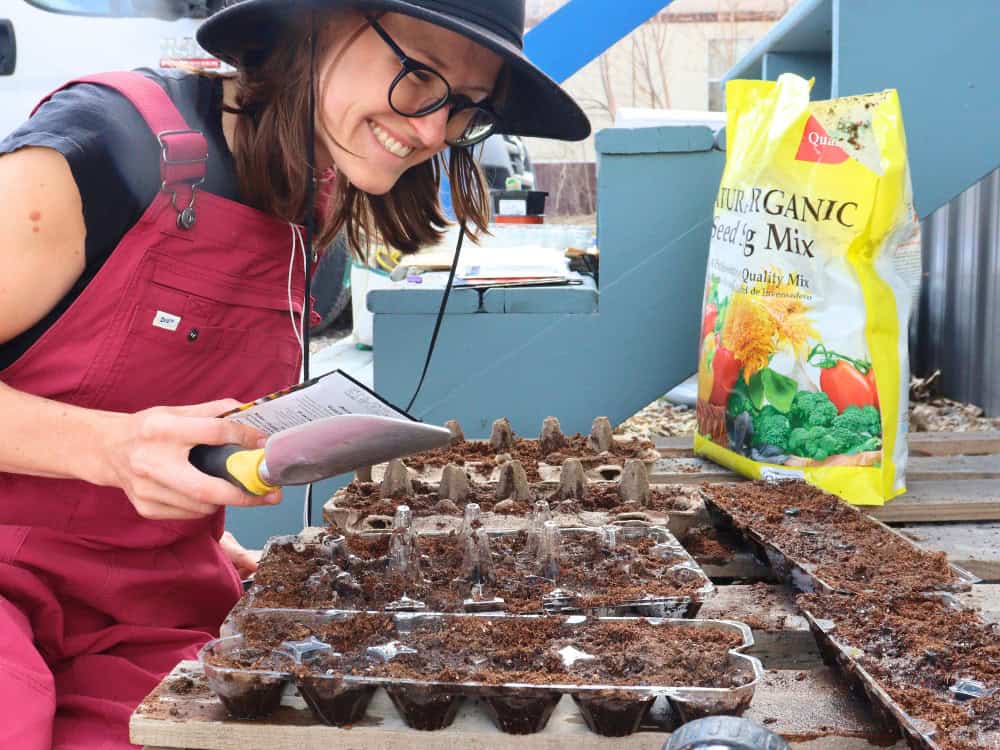
Use your nutrient-rich compost to grow your very own sustainable garden.
Perfect for amending soil and providing nutrients to plants, you can use your homemade compost to grow fresh herbs, salad greens, and all manner of vegetables, putting you well on your way to living waste-free.
Did you know we Have a Newsletter?
We cover the latest in sustainable living, fashion, zero waste, beauty, travel, finance and more…
Pin these:



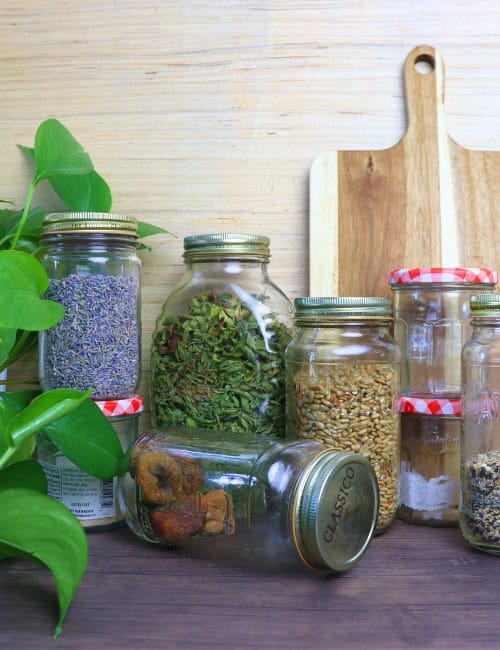
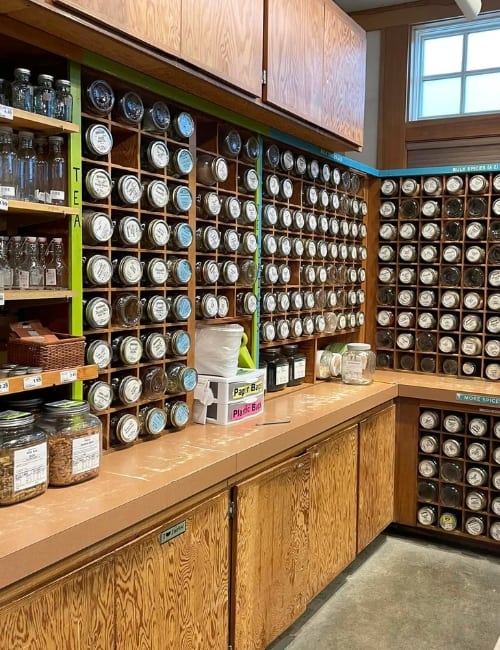
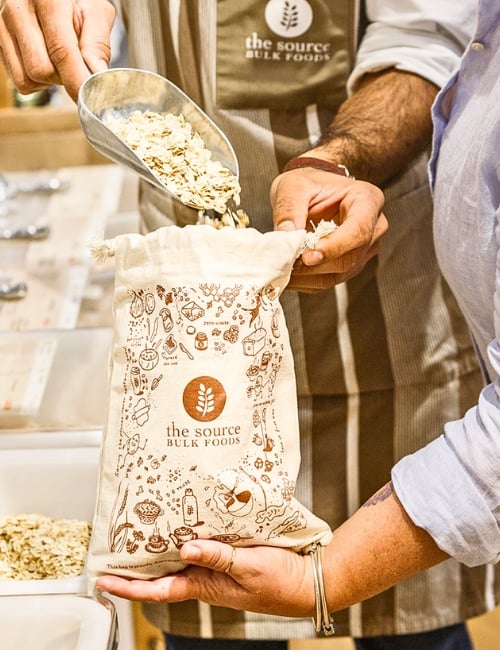
these are such great ideas! I seriously never even considered bringing my own containers to take leftovers home from a restaurant!
I can only suggest, glass straws, they are unbelievable and strong. Special glass that is child safe. http://www.strawhopper.com . Love your site.
Thank you for providing a deeper dive into no-waste! It was helpful to see some new ideas.
I’ve started following this zero waste idea one year ago and I’m familiar with some of these tips. But some of them are new to me and will definitely help me improve my zero waste lifestyle. Great article, as always!